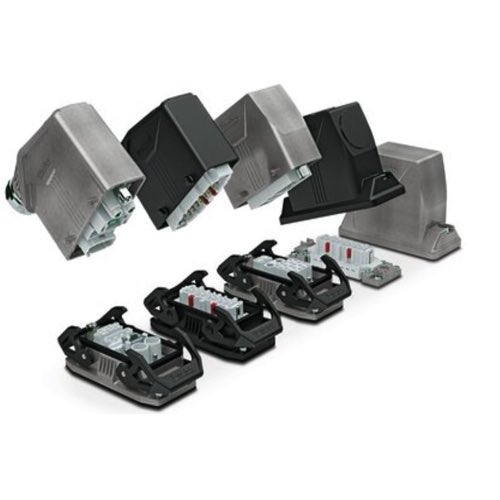Heavy Duty Connectors

In heavy-duty connectors, reliable power, data, and signal transmission is a must—an absolute requirement. Power, signal, and data transmissions must be reliable for the types of industrial applications that use heavy-duty connectors. They cannot be used in situations where water, dust, or so-called "extreme" temperatures could compromise the operation of the devices being powered, signaled, and fed with data. Even if the connectors themselves are rugged, the devices they connect must be robust power, signal, and data transmission devices.
Heavy-duty connectors are robust connection technologies in one housing, ensuring stable and secure connections by using advanced features like formed contacts and cable glands. Their use is not limited to the industrial sector, but their design readily meets the requirements of harsh-environment applications. More than just a negotiation between two sides, connecting means dangerous work. Heavy-duty connectors may be designed for performing critical tasks (like delivering power or maintaining an error-free data stream), but they are also designed to ensure personal safety and system integrity under harsh environmental conditions.
More Information about Heavy Duty Connectors
Industrial connectors cover a wide product range that caters to various industrial needs. Even among these specialized connectors, heavy-duty connectors stand out for their robustness and flexibility. They are built to withstand high temperatures and have long lifespans. They provide efficient power and signal transfer. Their adaptability makes them a standard choice for basically any kind of industrial application. Yet, the heavy-duty connector market is characterized by a diversity of designs and a wide range of features, covering a great variety of configurations and setups.
FAQs
What is the right connection technology in a single connector or individual connector to use in a modular system?
The right connection technology for a modular system is a modular connector, such as a multi-pin circular or rectangular connector, which allows for flexible, reliable, and easy integration of multiple functions within a single connector housing.
Can a heavy duty connector contact insert provide safe transmission with little electromagnetic interference in housings with a compact design?
Yes, a heavy-duty connector contact insert can provide safe transmission with minimal electromagnetic interference in housings with a compact design, ensuring reliable and secure connections even in space-constrained environments.
Can a heavy duty connector transmit power to a control cabinet under the harshest conditions?
Yes, a heavy-duty connector can transmit power to a control cabinet under the harshest conditions due to its robust design, durable housing, and ability to withstand extreme environments.
Serial Communication Basics
In telecommunications, the process of sending data sequentially over a computer bus or communication cable is known as serial communication. Serial communication transmits data one bit at a time. Parallel communication transmits bits simultaneously over multiple communication lines in a single bus or cable. While it may seem that parallel communication would be the preferred method, this is not true in many situations.
Because of the increased complexity and data transmission, serial communication has faster speeds than parallel communication. The speed at which serial is communicated can be altered by adjusting what is known as the BOD rate, which simply increases the number of the bits that can be transmitted per second. This is one of the reasons serial communication methods have remained such a common method for basic communication in much of computer based hardware used today.
Some of the most common standards that have been created to take advantage of serial based communication in the industrial space would be RS 232 and RS 485. The earlier RS 232 standard was very common in computing in many different industrial, commercial and residential applications. It had lower transmission speeds, short maximum cable lengths and large voltage swings, making it useful only in certain situations. RS 485 is an improved standard that is still found in many of the same applications today. It resolved many of the issues the earlier RS 232 standard had by allowing longer cable lengths, higher transmission speeds and other improvements that increased its usability and performance.

